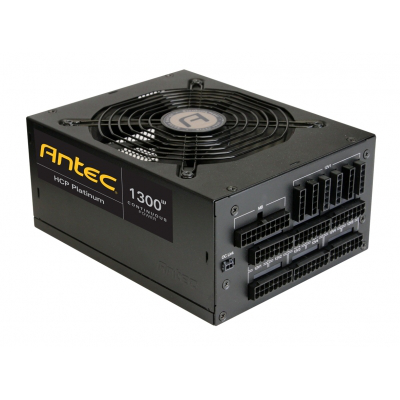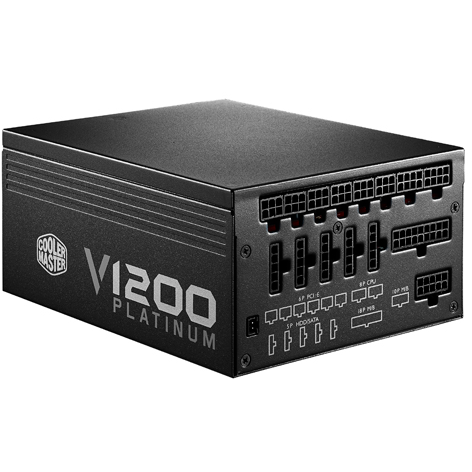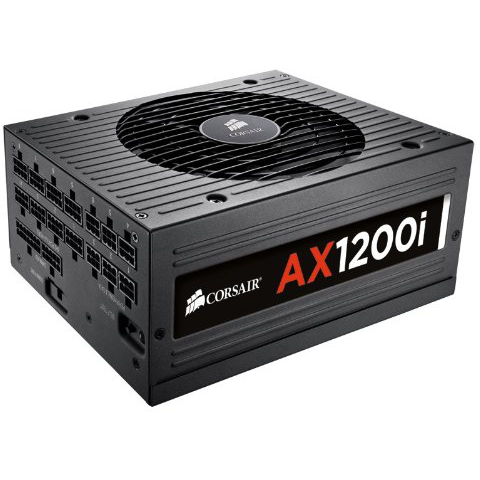Five Highly Efficient Power Supplies: 1200 W and Up
Until recently, buying a PSU with a four-digit wattage was perhaps most useful for boasting among fellow hardware enthusiasts – there was barely any real need for such high wattages. However, Bitcoin mining and Altcoin mining have changed that.
Power, More Power and Excellent Efficiency
Why you can trust Tom's Hardware
Often, the requirements imposed on a product contradict each other or force the designers to find a middle ground: A high-wattage power supply achieving extremely high efficiency seems as unlikely as a sports car achieving 50 miles per gallon. However, the five PSUs in our test claim to do just that – one of them, the Corsair AX1500i, even specifies 90 to 94 percent efficiency at 1500 W sustained power. This power supply is the first power supply in our lab which is adorned by the 80 Plus Titanium logo – currently, there is no better rating. However, this impressive combination of power and efficiency comes at a hefty price: $450, almost twice what some Platinum-grade 1200 W PSUs command. Thus, if your use case doesn’t demand 1500 W or Titanium efficiency, you may be better advised to acquire a Platinum-grade 1200 W or 1300 W PSU. We included three of them in this test: The $280 Antec HCP-1300 Platinum, the $245 Cooler Master V1200, and the $270 Seasonic Platinum-1200. The fifth PSU in this test once again sports 1500 W, but at ‘merely’ Platinum efficiency: The Enermax Platimax EPM1500EGT, which doesn’t seem to be available in the U.S. yet.
But let’s return to the question: Who even needs such a powerful PSU? Average desktop PCs only need a 400 W PSU, if that. Some PCs even come with inexpensive 300 W PSUs. Even a high-end gaming rig typically doesn’t need more than a 750 W PSU, unless it contains multiple graphics cards. Using multiple graphics cards in a gaming PC is, however, a rare occurrence, as modern graphics cards are sufficiently powerful even for the most demanding games – there is simply no need for combining graphics cards via Nvidia’s SLI or AMD’s CrossFire. However, the demand for PSUs with more than 1000 W went through the roof during the past few months, and the reason is Bitcoin mining and Altcoin mining. Altcoin mining, by and large, still relies on graphics cards, although the first Scrypt ASICs are now available. However, Bitcoin mining rigs have not been based on graphics cards for more than a year – instead, these rigs are based on dedicated Bitcoin mining ASICs, whose DC-DC converters draw plenty of amps at 12 V. Enermax confirmed that the Platimax 1500 is flying off the shelves, and the same goes for all other high-wattage PSUs.
Lab Note: 80 Plus Certification at 230 V
Up till now, the 80 Plus organization Ecova Plug Load Solutions has been certifying PSUs at 115 V input voltage. 230 V-only PSUs were not eligible for the coveted 80 Plus certificate – conducting the test at 230 V would favor 230 V PSUs, as primary side currents, and by implication also resistive losses, are lower at 230 V. However, the certification agency recently introduced 80 Plus 230 V logos, whose efficiency thresholds are slightly more stringent, taking the higher efficiency of 230 V PSUs into account. That said, none of the PSUs in this round-up test, not even the 230 V-only Enermax Platimax, sported the new logo. Perhaps the 80 Plus 230 V logo is just too new.
Technical Specifications
| Retail Price (Froogle.com) | $280 | $245 | $450 | n/a | $270 |
|---|---|---|---|---|---|
| Power Certification | 80 PLUS Platinum | 80 PLUS Platinum | 80 PLUS Titanium | 80 PLUS Platinum (not yet certified) | 80 PLUS Platinum |
| Dimensions (WxDxH) | 5.9” x 7.48” x 3.39” | 5.9”x 7.48”x 3.39” | 5.9” x 8.86” x 3.39” | 5.9”x 7.09” x 3.39” | 5.9”x 7.48”x 3.39” |
| Weight | 4.9 lbs. | 9.5 lbs. | 9.7 lbs. | 5 lbs. | 9.5 lbs. |
| Operating Temperature | 32 - 122 °F | 32 - 104 °F | 32 - 122 °F | 32 - 104 °F | 32 – 122 °F |
| Warranty | 7 years | 7 years | 7 years | 5 years | 7 years |
| Power Specifications | |||||
| Specification | ATX12V v2.4 | ATX12V v2.31 | ATX12V v2.4 | ATX12V v2.4 | ATX12V v2.4 |
| Specified Output Power | 1300 W | 1200 W | 1500 W | 1500 W | 1200 W |
| Max. Peak Output | 1500 W | n/a | 1650 W | 1650 W | n/a |
| AC Input | 110 - 240 V | 100 - 240 V | 100 - 240 V | 220 - 240 V | 100 - 240 V |
| AC Voltage Selection | Auto voltage | Auto voltage | Auto voltage | Auto voltage | Auto voltage |
| DC Output +3.3 V | 25 A | 25 A | 30 A | 24 A | 25 A |
| DC Output +5 V | 25 A | 25 A | 30 A | 24 A | 25 A |
| DC Output +12 V (#1) | 50 A | 100 A | 125 A | 30 A | 100 A |
| DC Output +12 V (#2) | 50 A | n/a | n/a | 30 A | n/a |
| DC Output +12 V (#3) | 50 A | n/a | n/a | 30 A | n/a |
| DC Output +12 V (#4) | 50 A | n/a | n/a | 30 A (12V4,5,6) | n/a |
| DC Output -12 V | 0.5 A | 0.5 A | 0.8 A | 0.5 A | 0.5 |
| DC Power +12 V Combined | 1300 W | 1200 W | 1500 W | 1500 W | 1200 W |
| PFC | active | active | active | active | active |
| Specified Hold-Up Time | 17 ms | > 17 ms | n/a | 16 ms | >17 ms |
| MTBF | 100,000 hours | 100,000 hours | 100,000 hours | 100,000 hours | 150,000 hours |
| Cooling Specifications | |||||
| Main Fan | 135 mm | 135 mm | 140 mm | 139 mm | 120 mm |
| Main Fan Speed | up to 1800 rpm | n/a | up to 1200 rpm | 300 - 1000 rpm | up to 2400 rpm |
| Secondary Fan | n/a | n/a | n/a | n/a | n/a |
| Secondary Fan Speed | n/a | n/a | n/a | n/a | n/a |
| Connectors & Environmental | |||||
| 20+4 pin Motherboard | 1x (21.7”) | 1x (23.6”) | 1x (27.6”) | 1x (23.6”) | 1x (24”) |
| CPU | 2x | 2x (26.8”) | 2x (25.6” - 31.5”) | 2x (23.6” – 25.6”) | 2x (25.6”) |
| PCI Express 6-pin/6+2-pin (Graphics) | 0/10x (21.7” - 25.6”) | 0/12x (19.7” – 28.3”) | 0/10x (25.6” - 31.5”) | 0/10x (19.7”) | 0/10x (21.7” - 25.6”) |
| Molex 4-pin (Peripherals) | 6x (19.7” – 31.5”) | 9x (15.7” - 27.6”) | 12x (17.7” – 29.5”) | 10x (17.7” - 35.4”) | 5x (11.8” – 25.2”) |
| SATA Power | 9x (19.7” - 31.5”) | 12x (17.7” - 35.8”) | 20x (19.7” – 33.5”) | 14x (17.7” – 35.4”) | 14x (11.8” – 29.9”) |
| 4-pin Floppy | 1x (37.4”) | 1x (35.8”) | 2x (33.5”) | 2x (41.3”) | 1x |
| Product Specifics | |||||
| Accessories | Screws, Velcro Ties | Screws | Screws, Cable Ties | Screws, SafeGuard, Cable Ties | Cable Ties, Screws, Logo |
| Cable Management | Yes, fully modular | Yes, fully modular | Yes, fully modular | Yes, fully modular | Yes, fully modular |
| Other Details | OC Link | Hybrid Fan Control | Hybrid Fan Control | HeatGuard Extended Fan Run Time, CordGuard Mains Plug Safety Bracket, Twister-Bearing Fan | Hybrid Fan Control |
Current page: Power, More Power and Excellent Efficiency
Next Page Antec HCP-1300 PlatinumGet Tom's Hardware's best news and in-depth reviews, straight to your inbox.
-
blackmagnum I respect mother earth and her well-being; I will never hurt her by accepting these gluttonous monstrosities in my gaming builds. Low budget/ low power/ high efficiency FTW!Reply -
kevith Schön, dass Ihr auch deutsche artikeln jetzt schreibt. Das hätte ich mich nie gedacht. Aber was mit alle die amerikanischen leser? Die kann bestimmt kein deutsch?Reply -
damric Much better PSU review than usual for THW.Reply
However, none of these PSUs are as interesting as the SF Leadex. -
Alex Kelly Reply13853559 said:Much better PSU review than usual for THW.
However, none of these PSUs are as interesting as the SF Leadex.
Agreed! That's why I wanted to see the P2 here. -
nikolajj @blackmagnumReply
Well, you don't seem to understand fully.
They don't really consume more power than the connected hardware demands. On the other hand, they have an amazing efficiency rating, meaning that they use a minimum of power, and are therefore better for the planet. ;) -
mapesdhs Pity the Thermaltake Toughpower XT Gold 1475W wasn't included, I've obtainedReply
half a dozen of them recently, excellent PSUs.
Ian.
-
lp231 I still like the interior of my Antec TruePower Quattro 850w. Massive heatsinks!Reply
About that Antec 1300w PSU, according to their site, it says that has a "20+8-pin MBU socket for the needs of tomorrow."
Do you guys have any info on this?
http://store.antec.com/highcurrentpro/hcp-1300-platinum.html -
majormajormajormajor "At the time of writing, the website Plugloadsolutions.com only lists 7 Titanium-grade PSUs: Six models from a company called ‘Super Flower’ and the Corsair AX1500i"Reply
Wow, way to discredit yourself completely. You're reviewing power supplies and you've never heard of Super Flower?




